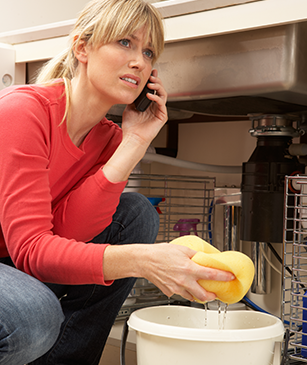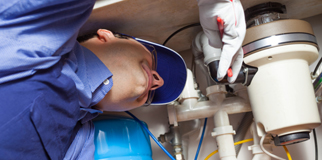Swift Solutions for Fixing a Dripping Waste Disposal Unit
Wiki Article
What are your concepts on Why Is My Garbage Disposal Leaking From the Bottom??

Garbage disposals are necessary kitchen area appliances that help in taking care of food waste efficiently. Nonetheless, a dripping waste disposal unit can be a frustrating and untidy issue to deal with. Thankfully, lots of leakages can be dealt with easily with a few straightforward steps. In this write-up, we will talk about just how to take care of a dripping waste disposal unit successfully.
Introduction
Garbage disposals are set up under kitchen sinks and are made to shred food waste right into smaller pieces, permitting it to travel through the plumbing system quickly. While these devices are generally trustworthy, leaks can take place gradually as a result of deterioration, loose links, or damage to the unit.
Common Root Causes Of Leaks in Garbage Disposals
Worn Seals and Gaskets
Seals and gaskets play a vital function in preventing water from dripping out of the waste disposal unit. With time, these parts can weaken, leading to leakages around the disposal unit.
Loose Links
The links between the garbage disposal and the plumbing system can end up being loose gradually, creating water to leak out during operation.
Fractures or Holes in the Disposal System
Physical damages to the garbage disposal, such as splits or holes in the real estate, can also result in leakages.
Recognizing the Source of the Leakage
Before trying to fix a dripping garbage disposal, it is important to recognize the resource of the leakage. This can typically be done through aesthetic inspection or by carrying out basic tests.
Visual Inspection
Evaluate the garbage disposal system carefully for any indicators of water leak. Pay close attention to locations around seals, gaskets, and connection factors.
Testing for Leaks
One way to evaluate for leaks is by running water with the disposal device and checking for any noticeable indications of leak.
Devices and Products Needed for Dealing With a Leaking Waste Disposal Unit
Prior to starting the repair work process, gather the essential devices and materials, consisting of a screwdriver, adjustable wrench, plumbing technician's putty, replacement seals or gaskets, and epoxy or patching product for repairing splits or holes.
Step-by-Step Overview to Repairing a Dripping Garbage Disposal
Switch off the Power
Before attempting any type of repairs, guarantee that the power to the waste disposal unit unit is shut off to stop the risk of electric shock.
Find the Leakage
Recognize the exact location of the leakage and determine the cause.
Tighten Links
Make use of a wrench to tighten any type of loose connections between the disposal system and the pipes system.
Change Seals or Gaskets
If the leakage is because of used seals or gaskets, eliminate the old parts and change them with brand-new ones.
Patching Fractures or Openings
For fractures or holes in the disposal unit, use epoxy or an ideal patching material to secure the damaged location.
Testing the Garbage Disposal After Fixing
Once the repair service is full, check the waste disposal unit by running water with it to make sure that the leakage has actually been resolved.
Preventive Upkeep Tips to Prevent Future Leakages
To prevent future leaks, it is essential to perform regular upkeep on your waste disposal unit. This consists of maintaining it tidy, staying clear of placing non-food products or hard things down the disposal, and occasionally looking for leaks or various other problems.
Verdict
In conclusion, taking care of a leaking waste disposal unit is a fairly straightforward procedure that can be finished with basic devices and materials. By complying with the actions outlined in this article and practicing preventative maintenance, you can maintain your waste disposal unit in good working condition and avoid costly repairs in the future.
HERE’S HOW TO FIX YOUR GARBAGE DISPOSAL
WHAT TO DO IF SOMETHING IS STUCK IN YOUR GARBAGE DISPOSAL
If the impeller won’t turn, there’s probably something stuck in the disposal. It could be a steak bone or peach pit, although plumbers report pulling all sorts of inappropriate objects out of disposals, such as bottle caps or aluminum foil. Make sure power to the disposal is off, and look inside to see if you can see the source of the jam.
Never stick your fingers in a disposal. Pull out anything you see with tongs or pliers.
If the disposal still won’t work, it may be time to call a plumber or consider buying a new disposal. GEM Plumbing & Heating is here for all of your garbage disposal needs.
WHAT TO DO IF YOUR GARBAGE DISPOSAL DRAIN IS CLOGGED
Take everything out from underneath your sink and put a bucket or other container under your disposal to catch any water that drains out.
Disconnect your disposal from the power supply.
If it’s plugged into a wall outlet, unplug it.
If it’s hardwired into an electrical box, go to the electrical panel and turn off the breaker for the disposal.
Pour ¼ cup of baking soda into the drain, followed by ½ cup of white vinegar. Give the solution a few minutes to fizz and do its work.
Look into the disposal with a flashlight to see if you can see an object that might be causing the clog. If you see it, remove it using tongs or pliers.
MORE TIPS ON DEALING WITH A CLOGGED GARBAGE DISPOSAL
Never use drain cleaner in a garbage disposal. It can damage the plastic parts inside the disposal. You can also be splashed with the caustic liquid while working to clear the clog.
Beware! Never stick your fingers into a garbage disposal. Trust us — not a good idea.
In many instances, your dishwasher drains through your garbage disposal. This allows the disposal to grind any large food particles that may be drained out of your dishwasher. There are some jurisdictions, however, where the plumbing code prohibits such a connection.
WHAT TO DO WHEN YOUR DISHWASHER DRAINS THROUGH THE DISPOSAL
Run some water in the sink so your plunger has at least a ½-inch of water to create a seal and plunge vigorously up and down several times. You may need to repeat this several times.
Run hot water down the drain to clear any residue that remains.

Hopefully you liked our article on Why Is . Thanks a lot for finding the time to read our article post. Remember to take the time to share this write-up if you liked it. Thank you for your time spent reading it.
Pricing Report this wiki page